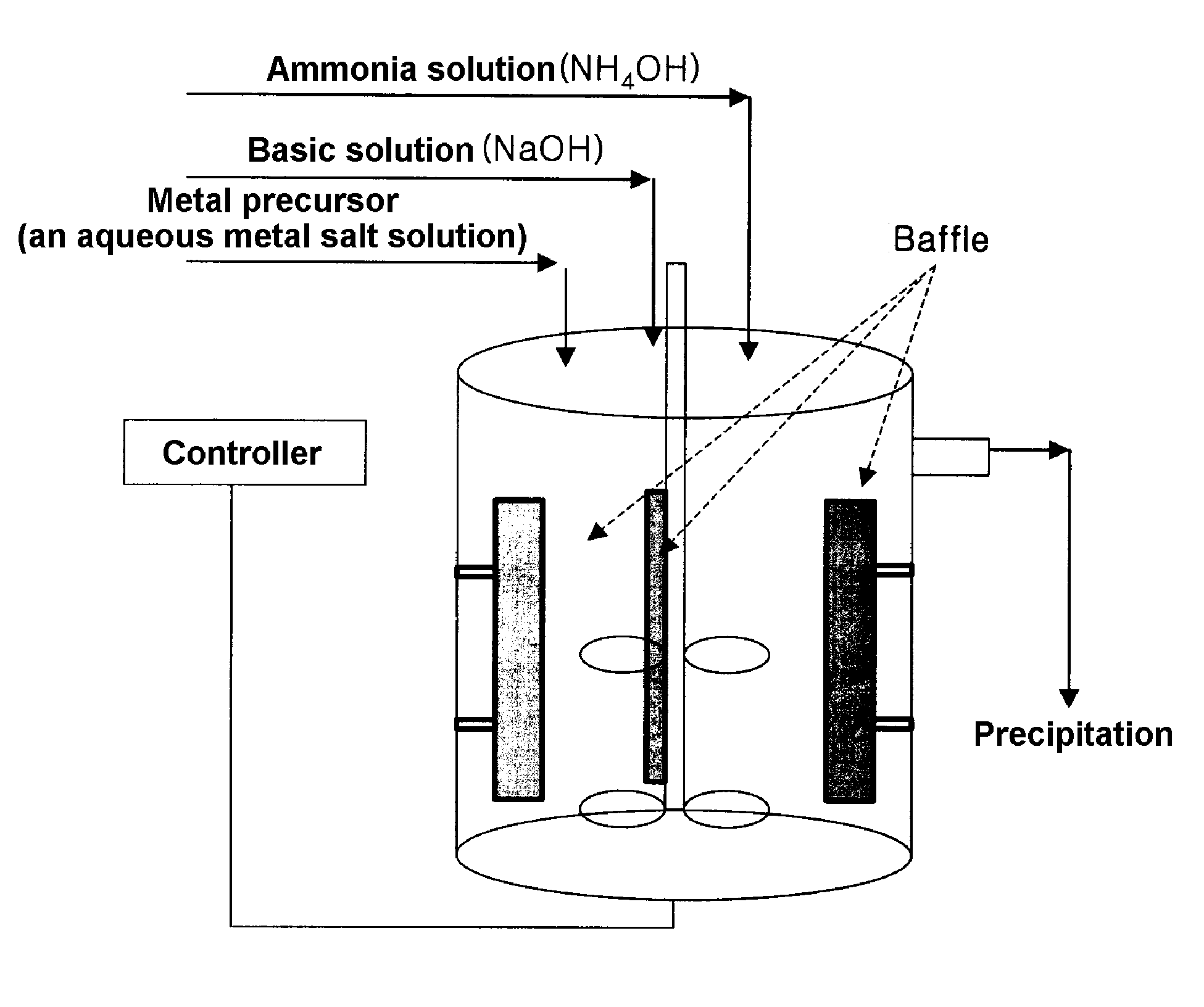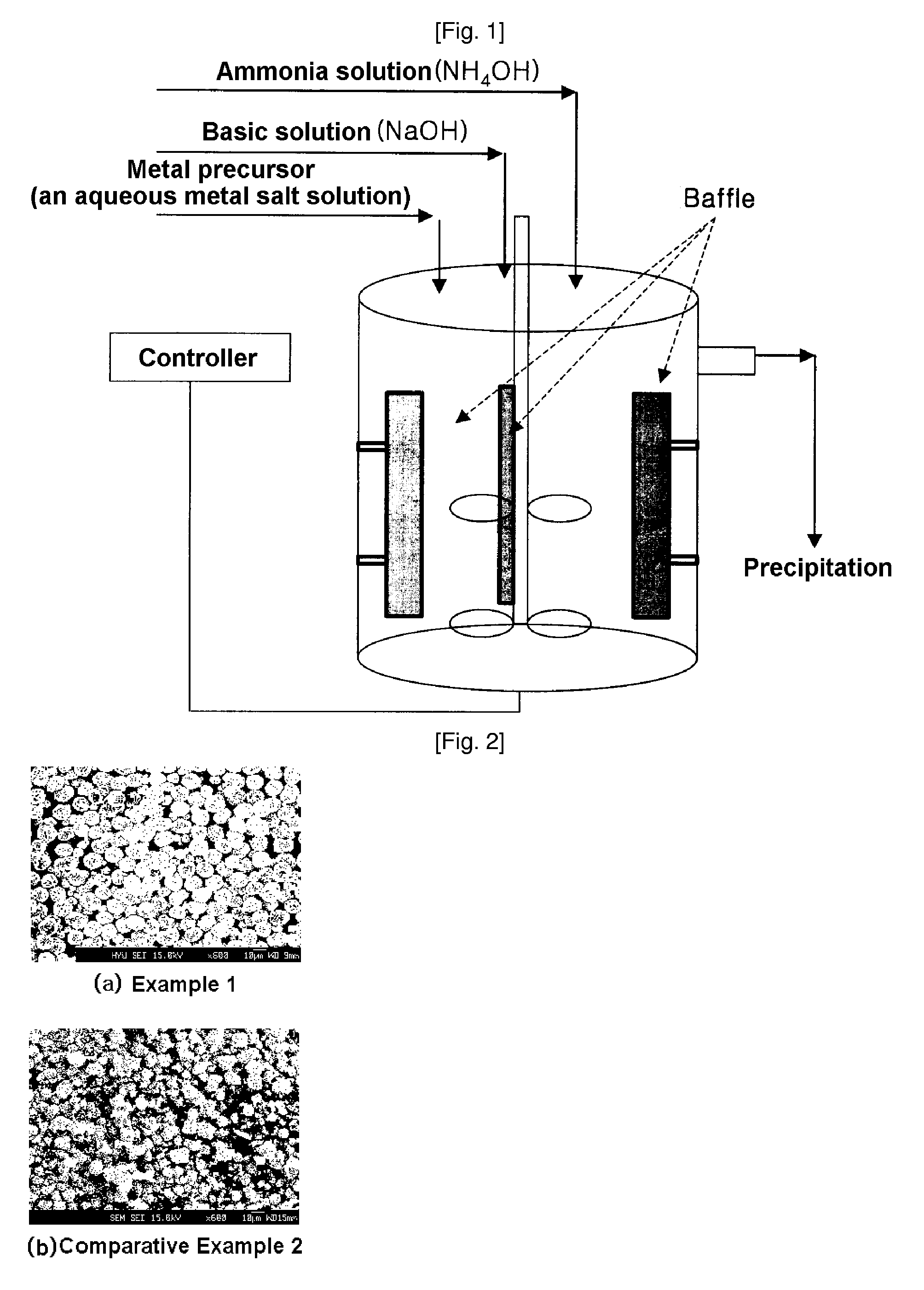Cathode active material for lithium secondary battery, process for preparing the same and reactor for use in the same process
a lithium secondary battery and active material technology, applied in the direction of nickel compounds, manganates/permanentates, cell components, etc., can solve the problems of poor characteristics inability to meet the demand, etc., and achieve high capacity cathode active and improve tap density
- Summary
- Abstract
- Description
- Claims
- Application Information
AI Technical Summary
Benefits of technology
Problems solved by technology
Method used
Image
Examples
example 1
[0058] To a 4 L reactor shown in FIG. 1 (output power of a rotary motor: more than 80 W) was charged 4 L of distilled water and then a sodium hydroxide solution was added to adjust the pH to 11.0 and nitrogen gas was bubbled in the reactor at a rate of 1 L / min so as to remove dissolved oxygen. The reactants were stirred at 1000 rpm while maintaining the temperature of the reactor at 50° C. A 3M aqueous metal solution, in which nickel sulfate, manganese sulfate and cobalt sulfate were mixed in a mol ratio of 1:1:1, was added at a rate of 0.5 L / hr to the reactor, followed by continuous addition of a 0.9M ammonia solution at a rate of 0.35 L / hr. A 5M sodium hydroxide solution, which serves to adjust the pH, was automatically added according to the predetermined pH. At this time, the pH was adjusted to 11.0. A mean retention time of the solution was brought to about 6 hours by controlling flow rate thereof. After the reaction reached qualitative state, a nickel-manganese-cobalt composit...
example 2
[0062] Cathode active material powder Li[Ni1 / 3Mn1 / 3−0.002Co1 / 3Mg0.04]O2 was synthesized by performing the same procedure as in Example 1 except that an aqueous metal solution in which nickel sulfate, manganese sulfate, cobalt sulfate and magnesium sulfate were mixed in a mol ratio of 1:0.98:1:0.04 was used instead of a 3M aqueous metal solution in which nickel sulfate, manganese sulfate and cobalt sulfate were mixed in a mol ratio of 1:1:1, and then a coin-type half battery was prepared using the cathode active material thus obtained. FIG. 3b is an FE-SEM of cathode active material powder thus obtained.
example 3
[0063] Cathode active material powder Li[Ni1 / 3Mn1 / 3Co1 / 3−0.04B0.04]O2 was synthesized by performing the same procedure as in Example 1 except that an aqueous metal solution in which nickel sulfate, manganese sulfate, cobalt sulfate and boric acid were mixed in a mol ratio of 1:1:0.96:0.04 was used instead of a 3M aqueous metal solution containing nickel sulfate, manganese sulfate and cobalt sulfate were mixed in a mol ratio of 1:1:1, and then a coin-type half battery was prepared using the cathode active material thus obtained. FIG. 3c is an FE-SEM of cathode active material powder thus obtained.
PUM
 Login to View More
Login to View More Abstract
Description
Claims
Application Information
 Login to View More
Login to View More - R&D
- Intellectual Property
- Life Sciences
- Materials
- Tech Scout
- Unparalleled Data Quality
- Higher Quality Content
- 60% Fewer Hallucinations
Browse by: Latest US Patents, China's latest patents, Technical Efficacy Thesaurus, Application Domain, Technology Topic, Popular Technical Reports.
© 2025 PatSnap. All rights reserved.Legal|Privacy policy|Modern Slavery Act Transparency Statement|Sitemap|About US| Contact US: help@patsnap.com



